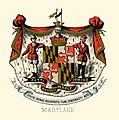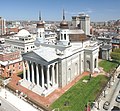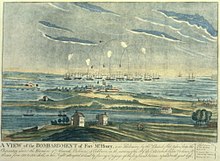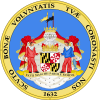|
Maryland Portal
|
Baltimore Task Force
|
Frederick Task Force
|
Montgomery Task Force
|
WikiProject Maryland
|
|
Main page
|
Discussion
|
Introduction Maryland (US: /ˈmɛrɪlənd/ MERR-il-ənd) is a state in the Mid-Atlantic region of the United States. The state borders Virginia to its south, West Virginia to its west, Pennsylvania to its north, and Delaware, the Atlantic Ocean, and the national capital of Washington, D.C. to its east. With a total area of 12,407 square miles (32,130 km2), Maryland is the ninth-smallest state by land area, and its population of 6,177,224 ranks it the 18th-most populous state and the fifth-most densely populated. Maryland's capital is Annapolis, and the most populous city is Baltimore. Occasional nicknames include Old Line State, the Free State, and the Chesapeake Bay State. It is named after Henrietta Maria, the French-born queen of England, Scotland, and Ireland during the 17th century. Maryland's coastline was first explored by Europeans in the 16th century. Prior to that, it was inhabited by several Native American tribes, mostly the Algonquian peoples and, to a lesser degree, Iroquoians and Siouans. As one of the original Thirteen Colonies, Maryland was founded by George Calvert, 1st Baron Baltimore, a Catholic convert who sought to provide a religious haven for Catholics persecuted in England. In 1632, Charles I of England granted Lord Baltimore a colonial charter, naming the colony after his wife, Henrietta Maria. Unlike the Pilgrims and Puritans, Lord Baltimore envisioned a colony where people of different religious sects would coexist under the principle of toleration. In 1649, the Maryland General Assembly passed an Act Concerning Religion, which enshrined this principle by penalizing anyone who "reproached" a fellow Marylander based on religious affiliation. Religious strife was common in Maryland's early years, and Catholics remained a minority, albeit in greater numbers than in any other English colony. Maryland's early settlements and population centers clustered around rivers and other waterways that empty into the Chesapeake Bay. Its economy was heavily plantation-based and centered mostly on the cultivation of tobacco. Demand for cheap labor from Maryland colonists led to the importation of numerous indentured servants and enslaved Africans. In 1760, Maryland's current boundaries took form following the settlement of a long-running border dispute with Pennsylvania. Maryland was an active participant in the events leading up to the American Revolution, and in 1776, its delegates to the Second Continental Congress in Philadelphia signed the Declaration of Independence. Many of its citizens subsequently played key political and military roles in the American Revolutionary War. Although it was a slave state, Maryland remained in the Union during the American Civil War, and its strategic location made it a significant strategic location during the war. After the Civil War ended, Maryland took part in the Industrial Revolution, driven by its seaports, railroad networks, and mass immigration from Europe. Since the 1940s, the state's population has grown rapidly, to approximately six million residents, and it is among the most densely populated U.S. states. , Maryland had the highest median household income of any state, owing in large part to its proximity to Washington, D.C., and a highly diversified economy spanning manufacturing, retail services, public administration, real estate, higher education, information technology, defense contracting, health care, and biotechnology. Maryland is one of the most multicultural states in the country; it is one of the six states where non-Whites compose a majority of the population, with the fifth-highest percentage of African Americans, and high numbers of residents born in Africa, Asia, Central America, and the Caribbean. The state's central role in U.S. history is reflected by its hosting of some of the highest numbers of historic landmarks per capita. (Full article...) This is a Featured article, which represents some of the best content on English Wikipedia..
The Royal Blue was the Baltimore and Ohio Railroad (B&O)'s flagship passenger train between New York City and Washington, D.C., in the United States, beginning in 1890. The Baltimore-based B&O also used the name between 1890 and 1917 for its improved passenger service between New York and Washington, collectively dubbed the Royal Blue Line. Using variants such as the Royal Limited and Royal Special for individual Royal Blue trains, the B&O operated the service in partnership with the Reading Railroad and the Central Railroad of New Jersey. Principal intermediate cities served were Philadelphia, Wilmington, and Baltimore. Later, as Europe reeled from the carnage of World War I and connotations of European royalty fell into disfavor, the B&O discreetly omitted the sobriquet Royal Blue Line from its New York passenger service and the Royal Blue disappeared from B&O timetables. Beginning in 1917, former Royal Blue Line trains were renamed: the Royal Limited (inaugurated on May 15, 1898), for example, became the National Limited, continuing west from Washington to St. Louis via Cincinnati. During the Depression, the B&O hearkened back to the halcyon pre-World War I era when it launched a re-christened Royal Blue train between New York and Washington in 1935. The B&O finally discontinued all passenger service north of Baltimore on April 26, 1958, including the Royal Blue. Railroad historian Herbert Harwood said, in his seminal history of the service, "First conceived in late Victorian times to promote a new railroad line ... it was indeed one of the most memorable images in the transportation business, an inspired blend of majesty and mystique ... Royal Blue Line ... Royal Blue Trains ... the Royal Blue all meant different things at different times. But essentially they all symbolized one thing: the B&O's regal route." Between the 1890s and World War I, the B&O's six daily Royal Blue trains providing service between New York and Washington were noted for their luxury, elegant appearance, and speed. The car interiors were paneled in mahogany, had fully enclosed vestibules (instead of open platforms, still widely in use at the time on U.S. railroads), then-modern heating and lighting, and leaded glass windows. The car exteriors were painted a deep "Royal Saxony blue" color with gold leaf trim, a color personally chosen by the B&O's tenth president, Charles F. Mayer. (Full article...)General imagesIn the news
On this day...This is a Good article, an article that meets a core set of high editorial standards.
Eva Marie Cassidy (February 2, 1963 – November 2, 1996) was an American singer and musician known for her interpretations of jazz, folk, and blues music, sung with a powerful, emotive soprano voice. In 1992, she released her first album, The Other Side, a set of duets with go-go musician Chuck Brown, followed by the 1996 live solo album titled Live at Blues Alley. Although she had been honored by the Washington Area Music Association, she was virtually unknown outside her native Washington, D.C., at the time of her death from melanoma at the age of 33 in 1996. Two years after her death, Cassidy's music was brought to the attention of British audiences, when her versions of "Fields of Gold" and "Over the Rainbow" were played by Mike Harding and Terry Wogan on BBC Radio 2. Following the overwhelming response, a camcorder recording of "Over the Rainbow", taken at Blues Alley in Washington by her friend Bryan McCulley, was shown on BBC Two's Top of the Pops 2. Shortly afterwards, the compilation album Songbird climbed to the top of the UK Albums Chart, almost three years after its initial release. The chart success in the United Kingdom and Ireland led to increased recognition of Cassidy worldwide. Her posthumously released recordings, including three number-one albums and one number-one single in the UK, have sold more than ten million copies. Her music has also charted within the top 10 in Australia, Germany, Norway, Sweden and Switzerland. (Full article...)Selected article -The Battle of Baltimore (September 12–15, 1814) took place between British and American forces in the War of 1812. American forces repulsed sea and land invasions off the busy port city of Baltimore, Maryland, and killed the commander of the invading British forces. The British and Americans first met at the Battle of North Point. Though the Americans retreated, the battle was a successful delaying action that inflicted heavy casualties on the British, halted their advance, and allowed the defenders at Baltimore to prepare for an attack. (Full article...)Did you know?

SubcategoriesSelect [+] to view subcategories
TopicsRelated portalsAssociated WikimediaThe following Wikimedia Foundation sister projects provide more on this subject:
Discover Wikipedia using portals |























































